 The Institute for Bible Translation has released a new edition of the Gospel of Luke in the Nanai language. The previous edition was published in 2002. This year, IBT received a request from the Orthodox Metropolitan Ignatius of Khabarovsk and Priamur to reprint the translation of the Gospel of Luke in the Nanai language, accompanied by a parallel Russian Synodal translation.
The Institute for Bible Translation has released a new edition of the Gospel of Luke in the Nanai language. The previous edition was published in 2002. This year, IBT received a request from the Orthodox Metropolitan Ignatius of Khabarovsk and Priamur to reprint the translation of the Gospel of Luke in the Nanai language, accompanied by a parallel Russian Synodal translation.
In the introduction to the new edition Hieromonk Nikanor (Lepeshev), the Head of the ROC Khabarovsk and Priamur Metropolitan Commission on work with the indigenous peoples noted that "the first translations of the Bible into the languages of the Far Eastern aborigines were made in the 19th century by Orthodox missionaries. For this purpose alphabets were created for the Evenki (Tungus), Evens (Lamuts) and Nanais (Golds). Thus, these Far Eastern peoples obtained their scripts through the Orthodox Church. And the first book written and published in their languages was the sacred Gospel texts and Christian prayers. "
There are some pre-revolutionary translations of the Gospels in the languages of the indigenous inhabitants of the Amur region, made with the blessing of St. Innocent (Benjaminov), including: The Gospel of Matthew in Nanai (Golds) translated by Fr. Procopius Protodiakonov (1884), which has undeniable value as a historical and cultural monument, but for several reasons it is no longer useful for large-scale reading and distribution. Therefore the choice of the diocese when ordering a reissue was made in favour of the IBT translation.
The staff of the Institute for Bible Translation were pleased to learn that the book is in demand and that there is a need to release it again in a new format, which will bring the translation closer to the reader. The new edition of the Bible in the mother tongue of the local population, as a diglot, will help the clergy in their education work, serving as a link in a bilingual environment, and finally will become a tool for studying Nanai for those of its speakers who have partially lost their ancestral language.
Soon, IBT plans to work in collaboration with the Khabarovsk and Priamur Diocese on the audio recording of the Nanai text as well as on the continuation of the Nanai translation project.
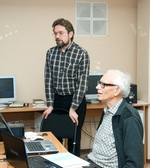 From October 24 to November 1, 2012 the Institute for Bible Translation held a Workshop on the discourse structure of Biblical texts. The course was attended by 38 participants - translators, editors, co-ordinators and consultants from 14 IBT Bible translation projects (Crimean Tatar, Dargin, Erzya-Mordvin, Ingush, Kabardian, Karakalpak, Komi-Zyryan, Komi-Permyak, Lak, Mari, Nenets, Nogai, Tabasaran, and Tajik).
From October 24 to November 1, 2012 the Institute for Bible Translation held a Workshop on the discourse structure of Biblical texts. The course was attended by 38 participants - translators, editors, co-ordinators and consultants from 14 IBT Bible translation projects (Crimean Tatar, Dargin, Erzya-Mordvin, Ingush, Kabardian, Karakalpak, Komi-Zyryan, Komi-Permyak, Lak, Mari, Nenets, Nogai, Tabasaran, and Tajik).
The goal of the workshop was to introduce the participants to a number of discourse-related topics that are of particular relevance to Bible translation, and to teach the participants to apply these concepts in practice in their translation work. During the seminar there was discussion of a wide range of questions which affect discourse analysis. The course gave an overview of the typology of languages, and considered the factors that affect changes in the usual word order, inter-sentential connectives in narrative, and connectives as imposing constraints on interpretation. Special attention was paid to the marked and unmarked indicators of participants in a narrative. Workshop participants learned how narrative develops in Greek, in Hebrew, and in the target language, how dialogues are expressed (by direct or indirect speech),  what is the role of dialogue in the story, what is background and foreground information, what are main arguments and supporting material, what is the difference between induction and deduction, what are the means of expressing exhortation, persuasion, different types of additional information, etc.
what is the role of dialogue in the story, what is background and foreground information, what are main arguments and supporting material, what is the difference between induction and deduction, what are the means of expressing exhortation, persuasion, different types of additional information, etc.
For all these topics lectures were presented first, followed by discussion of the actual work on translation into specific languages, and then practical work sessions were conducted on translation into the mother tongues of the participants.
To sum up, the participants noted that the analysis of texts in terms of discourse is very useful for their translation work, and as a result this course has increased their understanding that texts in different languages are constructed in different ways. So now they have the theoretical knowledge that will enable them all the better to solve certain translation problems.
The Second Peacemaking conference organized by the Public Chamber of the Chechen Republic, the Vladikavkaz and Makhachkala Diocese of the Russian Orthodox Church and the Naurskiy District Admi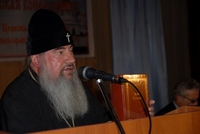 nistration was held on 22-23 October 2012 in the village of Naurskaya, Grozny. It was attended by representatives of religious communities, public organizations, administrative and academic institutions of the Chechen Republic, the Republic of Ingushetia, the Republic of North Ossetia-Alania, the Republic of Dagestan, Stavropol Region and Moscow. The conference discussed ssues of co-operation between the Orthodox Church and society in the North Caucasus.
nistration was held on 22-23 October 2012 in the village of Naurskaya, Grozny. It was attended by representatives of religious communities, public organizations, administrative and academic institutions of the Chechen Republic, the Republic of Ingushetia, the Republic of North Ossetia-Alania, the Republic of Dagestan, Stavropol Region and Moscow. The conference discussed ssues of co-operation between the Orthodox Church and society in the North Caucasus.
At the beginning of the forum, Archbishop Zosima of Vladikavkaz and Makhachkala presented to the audience the first translation of the Bible into the Chechen language, just published by the Institute for Bible Translation in Moscow.
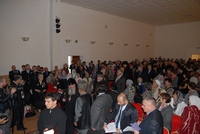 Archbishop Zosima said: "It is impossible to overestimate the work of the IBT Chechen translation team that gave this people a high-quality scholarly translation of the Bible into their native language. This result was achieved through a unique combination of talented translators fluent in their native language and world-class biblical scholars knowledgeable and experienced in scientifically developed methods of Biblical translation." "This publication has received the stamp of approval of the Institute of Linguistics of the Russian Academy of Sciences,” said the Archbishop. “It is designed for those who wish to get acquainted with the Bible in their native language in order to better understand another religion, another culture. It is no secret that many problems arise from ignorance. The more we know about each other, the better we understand each other. "
Archbishop Zosima said: "It is impossible to overestimate the work of the IBT Chechen translation team that gave this people a high-quality scholarly translation of the Bible into their native language. This result was achieved through a unique combination of talented translators fluent in their native language and world-class biblical scholars knowledgeable and experienced in scientifically developed methods of Biblical translation." "This publication has received the stamp of approval of the Institute of Linguistics of the Russian Academy of Sciences,” said the Archbishop. “It is designed for those who wish to get acquainted with the Bible in their native language in order to better understand another religion, another culture. It is no secret that many problems arise from ignorance. The more we know about each other, the better we understand each other. "
Speakers were unanimous in the view that a dialog of all nations and all religions is needed for a peaceful life. North Caucasian peoples are destined to live together, and they have to learn to understand each other and live in peace and harmony. As Archbishop Zosima said, "God is One for all, and if we all live by the commandments of God, then peace will reign on the earth."
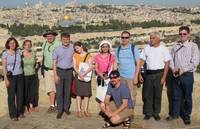 From 24 September to 4 October 2012 eight exegetical advisers of the Institute of Bible Translation (IBT Russia/CIS) took an orientation course in Israel conducted by the Home for Bible Translators. This was a short but exceedingly intensive Bible study course designed for the consultants of Bible translation projects with some background in Biblical languages.
From 24 September to 4 October 2012 eight exegetical advisers of the Institute of Bible Translation (IBT Russia/CIS) took an orientation course in Israel conducted by the Home for Bible Translators. This was a short but exceedingly intensive Bible study course designed for the consultants of Bible translation projects with some background in Biblical languages.
Having journeyed through the land of the Bible with Bible in hand, the group learned many important facts about Hebrew meanings and about the land of the Bible. They also heard lectures on relevant subjects. The intensive daily study tours covered the main biblical and archeological sites. The language of instruction was English, but the biblical passages were given in the Hebrew (OT) or Greek (NT) originals with Russian side by side.
Upon their return the group shared their impressions: “What impressed me most of all was the diversity (geographical, climatic, and agricultural) of the Land in its compactness and the complexity of its history”. “This course opened my eyes to read and understand the Bible differently. It gave life to my one-dimensional understanding of the Bible. It challenged me to address the Bible in the context of the history, topology, geography and culture of the land of the Bible. I was certainly challenged to learn Hebrew at a deeper level. However, what I have seen and heard have become great resources which I can reflect in the work of Bible translation”.
IBT hopes that the information and the insights gained during this visit to Israel will assist IBT exegetes when they consult, advise and train national translators.
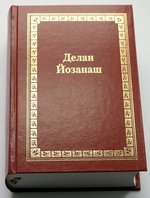 The Institute for Bible Translation (IBT, Moscow) has published the result of more than 15 years of work by a large international group of translators and biblical scholars – the translation of the Bible into the Chechen language. This is the fourth translation of the whole Bible in Russia after Russian, Chuvash and Tuvin. It is also the fourth translation of the whole Bible made by IBT in general - after Tajik (1992, IBT Stockholm), Georgian (2002, IBT Stockholm), and Tuvin (2011, IBT Moscow).
The Institute for Bible Translation (IBT, Moscow) has published the result of more than 15 years of work by a large international group of translators and biblical scholars – the translation of the Bible into the Chechen language. This is the fourth translation of the whole Bible in Russia after Russian, Chuvash and Tuvin. It is also the fourth translation of the whole Bible made by IBT in general - after Tajik (1992, IBT Stockholm), Georgian (2002, IBT Stockholm), and Tuvin (2011, IBT Moscow).
In the process of translation of the Bible into Chechen IBT published separate books as follows: John / Acts (1986, 1995), Luke (1998, 2004, 2010), Genesis, Ruth, Jonah (2002), Esther, Ecclesiastes, Lamentations and the Book of Daniel (2005), the New Testament (2007) and "Bible Stories" (2010).
The Chechen language has a good literary tradition. The emergence of the written Chechen language dates back to the 18th century, when the Arabic script was adapted for the Chechen language. Later, in 1862, the first Chechen dictionary was produced based on the Cyrillic alphabet. Modern Chechen literature is represented by a variety of genres and writers.
This translation of the Bible in the Chechen language has the stamp of approval of the Institute of Linguistics of the Russian Academy of Sciences. According to reviews by experts in the Chechen language, "the translation has truly been a success.”
The print run of the Bible in the Chechen language is 2000 copies. Given the total number of native speakers (by the last census it is about 1.5 million people) this is not a large number, but we hope that it will be enough to satisfy the needs of libraries, churches and interested readers who want to get acquainted with the Bible in their native language. The publication will go out to readers in October.
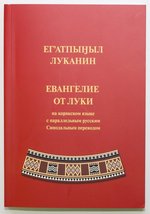 The Institute for Bible Translation started a series of Northern Diglots - publications of the translation of the Gospel of Luke in the languages of the indigenous peoples of the Far North and the Far East of Russia (Koryak, Itelmen, Chukchi, Nanai, Evenki & Even) with the parallel text of the Russian Synodal version. The series was initiated by appeals to IBT by the bishops of the Kamchatka, Khabarovsk and Chukotka Dioceses of the Russian Orthodox Church. It is planned that all the publications will come complete with audio recordings of the texts. Some recordings will be done locally in co-operation with the ROC Dioceses.
The Institute for Bible Translation started a series of Northern Diglots - publications of the translation of the Gospel of Luke in the languages of the indigenous peoples of the Far North and the Far East of Russia (Koryak, Itelmen, Chukchi, Nanai, Evenki & Even) with the parallel text of the Russian Synodal version. The series was initiated by appeals to IBT by the bishops of the Kamchatka, Khabarovsk and Chukotka Dioceses of the Russian Orthodox Church. It is planned that all the publications will come complete with audio recordings of the texts. Some recordings will be done locally in co-operation with the ROC Dioceses.The first edition of the series – the Gospel of Luke in the Koryak language – has been released. It includes an introductory word by Bishop Artemiy of Kamchatka. The distribution, supported by the
 Russian donor, will be made on a charitable basis in churches, libraries, and schools.
Russian donor, will be made on a charitable basis in churches, libraries, and schools.It is planned that the other publications of the series will come to readers in 2012-2013. The next publication will be the Gospel of Luke in the Nanai language.
We hope that the publication of Northern Diglots will serve to preserve the languages and national cultures of the indigenous ethnic groups and will help in the missionary and educational activities of the Northern Dioceses.
 The Institute for Bible Translation has published the first translation of the Pentateuch in the language of the Dungans, approximately 90,000 people living in Kyrgyzstan, Kazakhstan and Uzbekistan. The Dungans are descendants of the Hui Muslims who migrated from China in the 19th century. They speak one of the north-eastern dialects of the Chinese language, but, unlike the Chinese, they use a form of the Cyrillic script, developed for them in the Soviet Union in the 1950s.
The Institute for Bible Translation has published the first translation of the Pentateuch in the language of the Dungans, approximately 90,000 people living in Kyrgyzstan, Kazakhstan and Uzbekistan. The Dungans are descendants of the Hui Muslims who migrated from China in the 19th century. They speak one of the north-eastern dialects of the Chinese language, but, unlike the Chinese, they use a form of the Cyrillic script, developed for them in the Soviet Union in the 1950s.
Earlier the Institute for Bible Translation published Four Gospels and the Acts of the Apostles (2006) and A Short Dungan-Russian Dictionary (2010) in the Dungan language. The Dungan translation project was launched in collaboration with the Department of Dungan Studies of the Kyrgyz National Academy of Sciences. The work of the project involved prominent Dungan linguists such as Abdurakhman Kalimov and others.
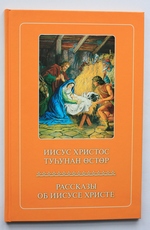 The Institute for Bible Translation has published a new colorful large-format illustrated book "Stories of Jesus Christ," in the Dolgan language, spoken on the Taimyr Peninsula. The Dolgans (numbering 7,885 people), whose national identity was recognized by scholars only in the 1960s, speak a Turkic language very close to Yakut.
The Institute for Bible Translation has published a new colorful large-format illustrated book "Stories of Jesus Christ," in the Dolgan language, spoken on the Taimyr Peninsula. The Dolgans (numbering 7,885 people), whose national identity was recognized by scholars only in the 1960s, speak a Turkic language very close to Yakut.
The text of this book is a translation into Dolgan of the stories from the New Testament part of the famous IBT Children’s Bible. To facilitate understanding for people who do not read Dolgan easily the relevant text in Russian is on the same page as the Dolgan translation.
In 1997 IBT published this book in Dolgan under the title "Jesus - Friend of Children." According to translator Nina Kudryakova, the text of this edition was difficult for the Dolgan readers. The present translation has been revised to be easier to understand for both adults and children. "Even Dolgan adults should be taught the written Dolgan language, because less than half of the population can read in Dolgan,” says Nina. Dolgan is studied at school, but as a foreign language along with English. The language is being forgotten and in Dolgan families the parents usually speak Russian with their children. Therefore we decided to print the book in both languages. This practice is common in Taimyr: almost all books and textbooks come in both languages, one page in Russian, and the other in Dolgan."
Earlier IBT also published the Gospel of Mark (1996) and Luke (2002) in Dolgan. In the coming years IBT will continue to work on the translation of the book of Acts.
26.06.12 I «Stories about Jesus Christ" in the Buryat language with a companion audio recording on CD
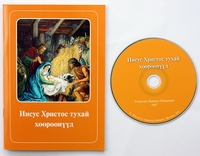 The Institute for Bible Translation in Moscow has released a children's book "Stories about Jesus Christ" in the Buryat language. The text of the book is a new edition of the New Testament part of the "Children’s Bible " in Buryat, published in 2004.
The Institute for Bible Translation in Moscow has released a children's book "Stories about Jesus Christ" in the Buryat language. The text of the book is a new edition of the New Testament part of the "Children’s Bible " in Buryat, published in 2004.
The translator Darima Raytsanova made the audio recording of the text especially for this edition. In her reading, the story of Jesus Christ sounds calm and natural, creating attractive and understandable Gospel images for the Buryat people. The book and the audio recording can be used by individuals, as well as in the process of education in schools. The books were distributed free of charge to the libraries and the churches of the Buryat Republic.
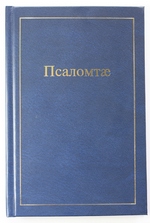 IBT has published a translation of Psalms in modern Ossetic. The translation was made on the basis of the oldest complete manuscript of the Hebrew text, as found in Biblia Hebraica Stuttgartensia. Subheadings and numbering follow those of the Russian Synodal Bible.
IBT has published a translation of Psalms in modern Ossetic. The translation was made on the basis of the oldest complete manuscript of the Hebrew text, as found in Biblia Hebraica Stuttgartensia. Subheadings and numbering follow those of the Russian Synodal Bible.
This publication is the third translation of the book of Psalms in Ossetic. Psalms were first published in book form in 1848 in St. Petersburg. And even earlier in 1798 individual psalms were included into the first printed book in the Ossetic language Catechism (in the Orthodox Church, the Catechism is a series of questions and answers about religious beliefs, which has to be learned by people before they can become full members of that Church).
The book of Psalms is the largest and one of the most widely read books of the Old Testament. In Hebrew, it is called ‘Tehillim’, meaning 'Songs of Praise', that is, a collection of songs and hymns glorifying God. In reading the Psalms one can derive consolation in life's sorrow and difficulties. This book covers various aspects of human life and talks about human sufferings, hopes, love, faith and the joys of life with God.
IBT thanks translators, editors and all those who participated in this study. We are pleased that Ossetic readers now have the opportunity to read this book in modern language.
Earlier in Ossetic IBT published the Children’s Bible and the New Testament in 2004, plus Genesis and Exodus in 2006.
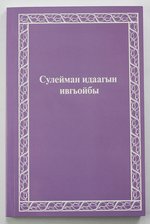 The translation of the biblical Book of Proverbs into Tsakhur has been published by the Institute for Bible Translation. For the newly written Tsakhur language which does not have a rich literary tradition, the appearance of any written documents, especially from the Bible, is a significant event, promoting the development of the language itself. Another important milestone in the history of the development and literary tradition in this language was the translation of the Gospel of Luke, released by IBT in 2003.
The translation of the biblical Book of Proverbs into Tsakhur has been published by the Institute for Bible Translation. For the newly written Tsakhur language which does not have a rich literary tradition, the appearance of any written documents, especially from the Bible, is a significant event, promoting the development of the language itself. Another important milestone in the history of the development and literary tradition in this language was the translation of the Gospel of Luke, released by IBT in 2003.
Prominent RF linguists were involved in working on these publications. The biblical books in Tsakhur have been translated by Dr Garoun Ibragimov, a Dagestan linguist, Professor at the Dagestan Pedagogical University, a passionate scholar, selflessly loving his mother tongue, who has turned out to be a talented translator. Dr Ibragimov’s excellent knowledge of and feeling for his native language and his high level of professionalism have made possible the appearance of the Book of Proverbs in Tsakhur. Ibragimov recently turned 80 years old. The publication of the book is a kind of gift for the anniversary of the translator. Invaluable help as theological adviser in the work of Dr Ibragimov was provided by Dr J. Testelets, a specialist in Caucasian languages, researcher at the Institute of Linguistics of the Russian Academy of Sciences (RAS), and Professor of Linguistic Typology in the Educational and Scientific Centre of the Institute of Linguistics of the Russian State University for the Humanities.
Sayings from the Book of Proverbs are based on the everyday experience of common people and are enriched by the sublime teachings of God's wisdom and the spirit of reverence for the Creator. IBT colleagues hope that the translation of this book will not only promote the increase of biblical wisdom, but will also become a significant phenomenon in the cultural life for the Tsakhurs.
01.03.12 I Hexapsalmos (Six Psalms) in the Gagauzi language for liturgical use
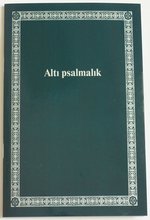 IBT has completed its work on the translation and publication of the Hexapsalmos (Six Psalms) in the Gagauzi language. The translation was made at the initiative of the clergy and parishioners of the Cahul-Comrat eparchy of the Orthodox Church in Moldova and was released in two scripts - Cyrillic (500 copies) and Roman (300 copies).
IBT has completed its work on the translation and publication of the Hexapsalmos (Six Psalms) in the Gagauzi language. The translation was made at the initiative of the clergy and parishioners of the Cahul-Comrat eparchy of the Orthodox Church in Moldova and was released in two scripts - Cyrillic (500 copies) and Roman (300 copies).
Hexapsalmos in the Orthodox liturgy denotes the six selected psalms (3, 37, 62, 87, 102, 142 according to the numbering in the Greek and Russian Bibles. In western Bibles that follow the Hebrew numbering system, these psalms are 3, 38, 63, 88, 103, 143). These psalms are consistently read at Matins (morning worship service) every day throughout the year, except for Easter Week.
In the work of preparing the publication of the Six Psalms, the following people participated Victor Kopuschu (translator), Dr Andrei.Desnitsky (IBT consultant), editors, Dr Irina Bankova and Peter Chebotar (editors), and Fr Sergius Kopuschu.
The translation was tested among the parishioners of the Orthodox churches of Gagauzia. The translation of the Six Psalms has received the blessing of Anatoliy, Bishop of Cahul and Comrat, and will be distributed free of charge to parishes in the Diocese of Cahul-Comrat for liturgical use, and home reading.
28.02.12 I “Stories about Jesus Christ" - an illustrated edition with parallel texts in Koryak and Russian
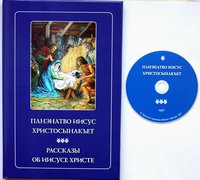 The Institute for Bible Translation has published a new colourful large-format illustrated edition "Stories about Jesus Christ" with parallel texts in Koryak and Russian and a companion audio recording of the Koryak text on CD. The text of this book contains selected stories from the New Testament part of the Children’s Bible.
The Institute for Bible Translation has published a new colourful large-format illustrated edition "Stories about Jesus Christ" with parallel texts in Koryak and Russian and a companion audio recording of the Koryak text on CD. The text of this book contains selected stories from the New Testament part of the Children’s Bible.
This publication has been prepared taking into account the socio-linguistic situation in Kamchatka. The Koryak, one of the indigenous peoples of Kamchatka, are bilingual: they speak the Russian language sometimes better than Koryak. The Koryak language belongs to the Chukchi-Kamchatka family of Palaeo-Asiatic languages. The number of speakers is about 9 thousand people. Unfortunately, the Koryak, living in a predominantly Russian-speaking environment, have partially forgotten their language, and reading in their native language is not a common thing for them, but still they remain Koryak, and continue thinking in the Koryak language. Through the distinctive worldview reflected in the language, the Koryak translation helps to bring the contents of the biblical text closer to the reader. To facilitate the reading of the Koryak translation anaudio recording was done, and the parallel Russian text was added to assist readers in learning the native language and to ease understanding.
 The books have already arrived in Kamchatka, having made the long journey by road from the Cheboksary printing house to Moscow, then to Vladivostok by train, then to Petropavlovsk-Kamchatsky by sea, and from there by truck again to Esso and Palana, where they will be used for free distribution to libraries, schools and churches. This book will be distributed during the dog sled race "Beringia-2012" (March 8-26, the length of the route - 1100 km.) to the distant places where communities of Koryak people live.
The books have already arrived in Kamchatka, having made the long journey by road from the Cheboksary printing house to Moscow, then to Vladivostok by train, then to Petropavlovsk-Kamchatsky by sea, and from there by truck again to Esso and Palana, where they will be used for free distribution to libraries, schools and churches. This book will be distributed during the dog sled race "Beringia-2012" (March 8-26, the length of the route - 1100 km.) to the distant places where communities of Koryak people live.
16.02.12 I The New Testament in Khakas with a parallel text in Russian
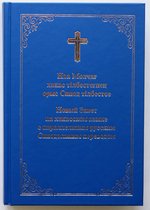 Following the publication of the New Testament in Khakas in 2009, IBT undertook the publication of the same translation in parallel with the Russian Synodal translation of the New Testament. Printed on thin Bible paper, this book with almost double the number of pages is of the same size as the previous monolingual edition. The project was undertaken at the initiative of the translation team and with the support of the partner organization SIL. According to reviews coming from Khakasia, the readers are enjoying the new book: "A beautiful design, good paper, easy to read, no need to turn separately to the Russian text." "This book makes the translation more accessible to different categories of Khakas readers."
Following the publication of the New Testament in Khakas in 2009, IBT undertook the publication of the same translation in parallel with the Russian Synodal translation of the New Testament. Printed on thin Bible paper, this book with almost double the number of pages is of the same size as the previous monolingual edition. The project was undertaken at the initiative of the translation team and with the support of the partner organization SIL. According to reviews coming from Khakasia, the readers are enjoying the new book: "A beautiful design, good paper, easy to read, no need to turn separately to the Russian text." "This book makes the translation more accessible to different categories of Khakas readers."
Upon arrival in the Republic of Khakasia the books were received for free distribution in the National Library, the Ministry of Education and Regional Policy, Abakan and Khakas Diocese of the Russian Orthodox Church and Protestant churches in the Republic. This publication continues the series of diglots that IBT is planning to complement the publications of separate Gospels and collections of Bible stories for children in the Koryak, Chukchi and Itelmen languages.
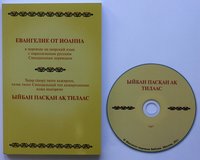 IBT has published a translation of the Gospel of John into the Shor language. The Shors are a numerically small Turkic people (14,000 speakers) living in the North Altai, and Mountain Shoria districts. This new edition continues the three-centuries-old tradition of diglot editions of biblical texts intended for different audiences. It can successfully be used as a manual for Shors who want to improve their knowledge of their native language. Also to assist the Shor reader the publication includes a sizeable Shor-Russian glossary. The book is accompanied by an audio recording of the Shor translation on CD. Since biblical concepts are not a part of active everyday Shor vocabulary, the sounds of these words will help the reader to get used to them in speech. It is expected that thanks to the audio the Shor lexical resources will be enriched, which will promote literacy in their native language.
IBT has published a translation of the Gospel of John into the Shor language. The Shors are a numerically small Turkic people (14,000 speakers) living in the North Altai, and Mountain Shoria districts. This new edition continues the three-centuries-old tradition of diglot editions of biblical texts intended for different audiences. It can successfully be used as a manual for Shors who want to improve their knowledge of their native language. Also to assist the Shor reader the publication includes a sizeable Shor-Russian glossary. The book is accompanied by an audio recording of the Shor translation on CD. Since biblical concepts are not a part of active everyday Shor vocabulary, the sounds of these words will help the reader to get used to them in speech. It is expected that thanks to the audio the Shor lexical resources will be enriched, which will promote literacy in their native language.
The Institute for Bible Translation has been working on translations of biblical texts into the Shor language since 2000. Until 2004 there was not one biblical text in the Shor language. IBT published the first complete Gospel of Mark (2004), and the Gospel of John (2008), and "Bible Stories" (2006). In the near future IBT is preparing to publish an illustrated book for children called "Biblical History", which is a reprint of a book published before the Revolution, containing a free paraphrase of the main books of the Old and New Testaments in the Shor language made in 1883 by a student of the Kazan seminary, the future priest John Shtygashev.

Share: